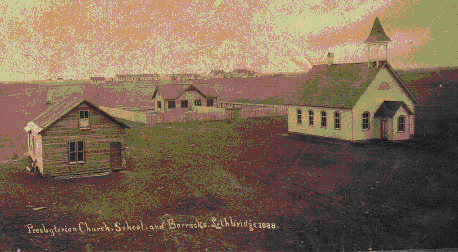
The transformation of a small mining town called Coalbanks into a city called Lethbridge took place in a relatively short time. The company town of Coalbanks began as the N.W.C.&N.Co.'s miners' camp, which opened when William Stafford and 15 Nova Scotia miners arrived to open the first drift mine on the west side of the Oldman River, while the mining camp was established on the other side of the river. The N.W.C.&N.Co. quickly established all of the facilities needed for mining operations. The company built not only mines but also barges, boats, offices, stores, and a saw mill. In addition, the company built homes for the miners and their families. A large home called Coaldale was built for Elliot Galt in 1883, and at the time it was considered to be the most prestigious dwelling south of Calgary. A slightly smaller home was built for William Stafford, who along with his wife and nine children, were among the first to settle at Coalbanks. For miners without families, the company built boarding houses, bunk houses, and shacks, all of which were rented at reasonable rates. Although Coalbanks was a company town, there were several other businessmen who established themselves. Two such businessmen were Joe Hall who operated a saloon and hop brewery south of Coalbanks, and O.S. Main who set up a slaughterhouse northwest of town.

P19640050000-GM A view of the town of Lethbridge above the river valley level.
By 1884, the population of Coalbanks peaked at about 250, and on October 31 of that year, the first baby, Henrietta Galt Lethbridge Stafford, was born. The first deaths were recorded earlier in August 1883, when 17 year-old Henry Stafford and his 23 year-old friend Britton Stephens died of typhoid. Their grave sites are marked and maintained today at The Stafford Grave in Indian Battle Park.
Before Coalbanks became firmly established in the river valley, settlement shifted above the river valley to the prairie level. In May, 1885 a modern town site was laid out by Montague Adous of the Dominion Land Survey. There was plenty of land on which the new community could expand, and as the miners and their families moved, only a small population of unmarried miners were left behind in the valley.
The town was initially named Coalbanks, as an expansion of the river community but its citizens preferred the name Lethbridge, after William Lethbridge, the first president of the N.W.C.&N.Co. Thus, in 1885 the new community was officially named Lethbridge.
The town grew quickly, and by 1891 it had a population of 1478 (although it had a male to female ratio of 3 to 1). In that year, the first elections were held and Charles Magrath, a local businessman and president of the Lethbridge board of trade, was elected as the first mayor. By this time, the town boasted over 60 buildings, including 6 stores, 5 hotels, 19 saloons, 4 billiard rooms, 2 barber shops, and a livery stable. In 1906, Lethbridge was incorporated as a city, laying the foundation for the important agricultural and industrial centre that it would soon become.
Previous Page | Exhibit Contents | Home | Navigation Information | Glossary | Curriculum Guide | Next Page
Copyright © 1996 Sir Alexander Galt Museum. All rights reserved.